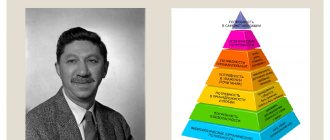Perhaps each of us has heard about self-actualization at least once. But few people have a clear idea of what it is. Which person is self-actualized and which is not? How to measure this? In the article you will learn about what it means to realize yourself, how to determine whether you are a self-actualized person or not, and what ways there are to become who you can potentially become. You can find out your strengths and weaknesses, decide on the vector of development and understand what you want in life in our online program “Self-Knowledge”.
What is self-actualization
What is self-actualization, what is its definition in psychology? Self-actualization is the process of personality formation, its psychological development. Every person has an inherent desire for the maximum realization of his abilities, inclinations, and capabilities. Self-actualization is based on a person's internal motives. The concept of “self-actualization” does not include passivity. A self-actualizing person himself strives to master new types of activities; he always has many plans and goals. He doesn't wait for the world to offer him something, he looks for opportunities himself.
The concept of self-actualization is closely related to the concept of self-realization. The first is the search for an answer to the question “Who am I, what should I be?” The second is the search for an answer to the question “What am I doing in order to be who I should be?” In science, the theory of self-actualization and self-realization of a person is closely related to humanistic psychology. In it, the concept of self-actualization is key. The term was introduced by K. Goldstein, who is also the author of the theory. However, besides him, the problem was studied by K. Rogers and A. Maslow. And their vision of the issue is discussed more often in psychology.
The authors’ concepts are somewhat different, for example, Maslow believed that one needs to develop actively, and Rogers preferred slow self-actualization (we’ll talk more about the types below). However, they agreed on the essence and specifics of self-actualization and believed that any person can achieve success in life if he begins to choose and direct his life. Self-actualization is the pinnacle in the theory of personality development.
The difficulty is that self-actualization largely depends on the developmental environment. What type of environment contains the potential for assumptions of favorable development of self-actualization? A friendly, developing environment, where there are warm and trusting relationships, where a person is supported and guided, and assistance is provided. It is extremely important that from an early age a person finds himself in such an environment, then the process of self-actualization will be simpler and more favorable.
Important! A self-actualizing person feels like a harmonious and whole person. He realizes his value and importance and feels that he is benefiting society.
How to define a self-actualizing personality?
Let's figure out how to identify a person in the society around us who is already in the stream of self-actualization. So, a person in the process of self-improvement has the following signs:
- Emotional openness: quickly and easily forgives sudden breakdowns of unrestrained or overly sensitive people.
- Complete control over your life: it is impossible to influence or put pressure on such people; they make their own decisions and do not depend on the opinions of others.
- Continuous striving for development and perfection - prefers to obtain new information from literature.
- Most often this is a creative person with positive thinking.
If there are people around you who do what they love, they are definitely among those who are in the process of self-actualization.
Maslow's self-actualization theory
Why don't all people reach the level of self-actualization? It's all about the pyramid of needs that Maslow defined. The transition to a new level is impossible without satisfying the needs of the previous level. Let's briefly consider Maslow's theory of self-actualization.
Levels of the pyramid of needs:
| Level (lowest to highest) | Characteristic |
| Physiological | At this level the need for food and water, sex, sleep, good health, etc. is located. This group includes everything without which a person will die, everything that helps him to exist as an organism. This is the animal level. |
| Security needs | This group of needs includes the desire to have comfortable and permanent housing, stable work, and confidence in the future. This level also includes psychological comfort, absence of stress and threats to physical or mental health, life in a stable society, etc. This is the level of the animal, smoothly transitioning into the social. |
| Social | The need for respect, acceptance, family, friends, communication, social interaction. In a broad sense, it can be defined as a need in society. This is the social level. |
| Self-esteem | The need for self-esteem, self-acceptance. At this level, it becomes more important for a person what he thinks about himself, and not what society thinks about him. He wants to be proud of himself, strives for comfort and inner harmony, self-love and total self-acceptance. |
| Self-actualization | The need for creative self-expression and social activity. At this level, a person tries to combine the two previous stages, that is, he seeks a balance between personal and social, he learns to be himself in the conditions of society. Harmony with himself is still important to him, but at the same time he is looking for ways of self-expression that will be accepted and appreciated by society and are useful to him. |
Self-actualization according to Maslow is based on 8 principles:
- Life "here and now". Not every person understands what is happening around him and inside him. You need to learn to live and understand every minute.
- Always choose growth, that is, experience and learning something new. This is closely related to the fear of the unknown.
- To live, not to exist. A person should do what he likes and not do what he doesn’t like. You cannot sacrifice your interests for the sake of other people.
- Be honest with yourself and others, be able to bear responsibility.
- Trust yourself, your impulses and feelings, and not what is supposedly accepted in society.
- Constantly develop your abilities, turn them into talents.
- Rebirth. The peak of experiences in which a person changes his attitude towards himself and other people.
- Identification and elimination of subconscious defense mechanisms (projection, repression, rationalization, etc.), development of conscious behavior.
Important! According to A. Maslow's theory of self-actualization, only the person who has reached the highest level is considered a harmonious, healthy, mature person.
Methods
Research by A. Maslow
Throughout its life, from the moment of conception, the body solves many problems. At first everything happens on an unconscious level. A creature, before becoming a conscious person, strives to satisfy needs, primarily fundamental ones. With the development of the body in general and awareness in particular, there is an increase in needs, among which A. Maslow names the 5 most common. You've probably heard of Maslow's pyramid.
So, he compiled a hierarchy: from the simplest to the highest level needs:
- basic (physiological or fundamental): water, food, sleep, etc.;
- safety (the instinct of self-preservation is triggered): daily routine, housing, clothing;
- love, belonging: society of relatives, friends;
- respect or participation in public life;
- self-actualization.
In order for us to satisfy the highest and at the same time complex need, we need to know how to do it. There are many techniques on how to start the mechanism consciously.
The most common methods of self-actualization
1. Full immersion. Gather your thoughts and let something consume you. Forget about protection, shyness. At this moment you will be filled with something very innocent, something fresh, your childish innocence will be reborn. Your usual cynicism will disappear, and your resilience and desire to appear wise beyond your years will simply disappear. To achieve such a state, one must be selfless. After all, very often we suffer from being too shy. But we very rarely perform truly selfless deeds.
2. Imagine that life is a process of continuous choice. You do it every moment: moving forward or taking a step back. You strive to protect yourself, looking for a safe shelter because you are afraid to leave your comfort zone. Or vice versa - you are ready for achievements, discover something new, grow and develop. If every day you make a choice in favor of development and growth, then you are already on the path to self-actualization, which implies this choice. That is, you discard everything that interferes with your personal growth.
3. Listen to your inner voice. This is how your inner self manifests itself. Unfortunately, now most people are accustomed to listening to the voices of others, instead of their own.
4. In times of doubt, be honest. Doubts are often accompanied by lies. Demand a clear answer from yourself, do not be afraid to become responsible for your choice, your decision. Only when you are fully responsible for what happens to you and what you don't have, do you self-actualize.
5. Develop your intelligence and your capabilities. Try to maximize the potential that is within you. For self-actualization, you need to work hard to turn what you want into reality. Think about it, each of us strives to become the best in the area in which we are really good.
6. Higher experiences are very important moments of self-actualization. That is, these are those very flashes of ecstasy, a feeling of complete satisfaction that cannot be obtained from the outside. Throw away all illusions, accept that there is something that is not yours, that you are simply not capable of. In this way, you will gradually reveal your potential, your true Self.
7. Essence. To understand yourself, discover your true essence, realize what is good and what is bad for you, and, ultimately, to find your purpose in life, you need to dig deep and understand your own psychopathology. To answer all these questions, you need to become aware of your defense mechanisms and overcome them. This is a complex process and very painful, because protection protects against what is unpleasant. However, you will be pleased with the result if you manage to overcome this barrier.
Areas of the self-actualization process
- socio-political activity;
- hobbies and hobbies;
- family;
- professional work.
Psychologist Otto Rank lists religion as a means of self-actualization. This is because through the lens of faith a person seeks to understand what makes him special. Another important way of self-actualization in modern society is joining cyberculture. After all, our world is a world of highly developed digital technologies. For this reason, knowledge of electronics and technology is a good way to adapt in society.
Creativity can be called a separate way of self-realization. It is used by people who have already realized some purely personal aspirations.
Self-actualization as a process
Most people reach level 3 or 4 and stop there. They have housing, a stable job (though not always a favorite one), friends and family, and hobbies. They go with the flow and seem to be happy with themselves and their lives. It would seem that everything is fine, but sometimes melancholy comes and then goes away. Why is it impossible to reach a new level, which complicates the process of self-actualization?
Taking yourself and your life into your own hands is really not easy. However, the instructions already exist; these conditions for self-actualization were identified by A. Maslow:
- Conscious and complete experience of any events. You can’t avoid problems, suppress negativity, or pretend that nothing happened if something doesn’t suit you.
- Recognizing that a person has a choice, using this feature. We make dozens of choices every day in every area of our lives. Doing nothing or going with the flow, putting something off until tomorrow again and again, enduring is also a choice. But does it really suit you?
- Changing attitudes towards responsibility. Choice always comes with responsibility. Many people choose to remain inactive because they are afraid to be held accountable for their actions. You need to realize that the ability to be responsible for yourself and others is a plus, not a minus.
- Where there is responsibility and choice, there is freedom and independence. This is exactly what a person wants, who seems to be doing well, but sometimes something is gnawing at him from the inside. In fact, he cannot think and act freely; he is locked within narrow limits. This makes him unhappy and holds back his personal potential.
- Self-trust, self-love, self-acceptance. Not all people are ready to talk frankly with themselves, to admit that they don’t like something about themselves, that something influences them from the outside.
- Recognizing problems (psychological, somatic, social, etc.) and working on them.
- Continuous creativity. It's not just drawing, singing or music. Creativity is coming up with something new and original. There is a place for this in every area of life.
Important! The more internal problems and barriers a person has and the more difficult his childhood was, the more difficult his self-actualization.
Motivations
Abraham argued that all the needs of the individual are located in a strictly hierarchical order. When lower-order needs are satisfied, higher-order needs arise.
And the motivation system, so widely used in personnel management, is based on the desire to satisfy them.
Even the most modest salary satisfies a person’s physiological needs: no one has the right to pay less than the subsistence minimum.
Since this minimum will be paid anywhere, you cannot keep an employee with money alone: you will have to satisfy his higher needs, and this is stability and security.
To do this, salaries must be paid regularly, without delay, so that there is confidence. But most employers also do this, so we rise to a higher level - social needs.
The key is that it doesn't cost much money to satisfy lower levels of needs, so why pay more when the job can be incentivized to satisfy higher levels?
This is communication: relationships within the team, relationships with clients, and so on.
This is the need for respect: praise and recognition of merit (chocolate medal, photograph on the honor board or in the corporate newspaper, on the company website, etc., conversations with the boss who convinces him of his indispensability).
This works even better than a salary increase.
Finally, the highest level is the need for development. Promise of career growth, expansion of responsibilities, etc.
Have you noticed what most job advertisements look like?
They affect all levels of the pyramid: “Stable salary, friendly team, career growth.”
The main points of the theory of motivation:
- All motives are hierarchical.
- Higher motives are insignificant until the lower ones are satisfied.
- The higher the level of the motive, the longer you can postpone their implementation.
- The higher the level of need, the greater the effort a person is willing to make to satisfy it.
The pyramid of needs is actively used in advertising. Any video focuses on satisfying some need.
For example, coffee is advertised not as a drink for energy, but as a means of communication, showing stories of how people meet over a cup of coffee, etc. Thus, the emphasis is on satisfying social needs, and those who lack communication will run for that coffee.
Based on the above, the cheaper the product, the lower levels of needs you can bet on; the more expensive, the higher.
Types of self-actualization
The process of formation and development of personality is strictly individual. However, it is possible to classify types of self-actualization according to how it manifests itself in three criteria: depth, harmony and activity.
Superficial and deep
Occurs most often. With this type, a person chaotically develops all his qualities and abilities, chooses any means of self-expression, and refuses to critically evaluate his actions. By proudly declaring “I am who I am,” a person demonstrates both strengths and weaknesses, both good personality traits and bad ones.
With a deep type of self-actualization, a person selectively approaches self-expression, struggles with his shortcomings and further develops his personal strengths. He constantly reflects, evaluates and analyzes himself and his actions. He tries to reveal and develop qualities that will help not only become happy, but also build harmonious relationships with society.
Harmonious and problematic
With a harmonious type, a person clearly knows where he is going, what talents and abilities he has. He rejoices in victories and learns from his mistakes, perceiving them as opportunities for growth. Society supports him.
With a problem type, a person cannot decide who and what he wants to be. He does not know himself and does not know what society wants him to be. He grabs first one thing and then another. Often disappointed in himself and conflicts with society.
Active and careful
With the active type, a person strives to achieve everything he has planned as soon as possible. Energy pours out of him; he infects others with his enthusiasm. Such people are not used to waiting and tend to take risks.
“The slower you go, the further you will go” is the motto of careful self-actualization. Such people are accustomed to carefully calculating, thinking through, and developing strategies. Sometimes they end up overtaking those who chose the active path.
Characteristics of a self-actualizing person
Maslow describes the self-actualizing individual as a person from whom nothing has been taken away. And an ordinary person is a creature who has drowned out the talents given by nature.
Are you ready to stop thinking about your problem and finally move on to real actions that will help you get rid of your problems once and for all? Then perhaps you will be interested in this article .
Parameters of personality self-actualization:
- realistic assessment of one’s own activities;
- accepting oneself with shortcomings;
- natural treatment of people, without pretense;
- actions and actions are aimed at achieving the goal;
- need for privacy;
- no dependence on the environment;
- even ordinary things are perceived as a miracle;
- ability for sensitive interpersonal relationships;
- freedom from prejudice.
But self-actualizing people are not ideal. Like others, they can be angry, irritable, boring, and selfish. A sign of a developing individual is temperamental outbursts. The characteristic of interpersonal relationships is the ability to quickly change from deep to cold.
In his research, Maslow gave the following example of the process of self-actualization: a woman who realized that she did not love her husband. She divorced her husband with cruelty and coldness, without worrying about his feelings. The realization of her potential was inadequate and developed into selfishness.
What is the motive for self-actualization?
Self-expression motive. If a person does what he does not want to do and does not do what his nature actually requires, then he will be unhappy. This strength, unsatisfied need, suppressed desires and abilities force him to move forward, to self-actualize. If a person was naturally meant to be a musician, but he tries to be a teacher, then he will not be satisfied with his life. This is the motive of self-actualization - the internal desire to live according to one’s nature. It reflects a person’s desire to be himself, this is his motivation for development.
Third adaptation
Another option was created in Yaroslavl at the Psychodiagnostics Scientific and Production Center in 1996 by A.A. Rukavishnikov under the leadership of V.I. Chirkova. Unlike the CAT methodology, LiO retained the structure of 150 questions and the categorical alternativeness of the proposed statements.
This version of the test contains 14 scales: Time scale (present), Time scale (past), Self-reliance, Reliance on others, Self-actualization value, Existentiality (flexibility of behavior), Reactive sensitivity, Spontaneity, Self-esteem, Self-acceptance, Human nature, Synergy , Acceptance of aggression, Ability to make close contacts. In addition, two relative values from the first four scales are calculated: Time Ratio and Support Ratio.
All scales included in the Personal Orientation Questionnaire have been fully tested for all necessary psychometric parameters (item analysis, homogeneity reliability, consistency reliability, construct and criterion validity). Psychometric testing of the questionnaire scales showed its high diagnostic suitability.
The sample for standardizing the questionnaire included 567 subjects aged 18 to 45 years (40% men and 60% women). Since no significant differences were found between the male and female samples, generalized norms are given for both groups.
Need for self-actualization
According to the theory of Carl Rogers, the need for self-actualization is inherent in every person from birth. Subconsciously, we all strive to become an integral and independent person. The psychologist believed that no circumstances can suppress the desire for self-actualization, and as soon as suitable conditions arise, it will burst out.
According to Maslow, the need for self-actualization manifests itself as an internal need for self-development, self-expression, self-realization and identity. The process of self-actualization corresponds to the biological predestination of the individual. Abilities (determined biologically) put forward needs. And while abilities are not revealed, a person will experience dissatisfaction and feel an internal craving for something that will help reveal these abilities. Expressed abilities give a feeling of satisfaction from realizing the manifestations of potential.
Let's look at what the need for self-actualization is with examples.
Examples
A great example of the need for self-actualization is starting a business. For example, one day a girl realizes that working in a 5/2 office and doing the same type of paperwork does not bring her joy. At the same time, she understands that she likes to draw, she is good at it. Inner strength forces her to analyze the profession market, where she finds the profession of a designer. She realizes that she could become one. Then her inner strength forces her to find suitable courses, the girl makes a list of qualities that she needs to develop in herself, and a step-by-step plan for achieving her goal - working as a designer (opening an individual entrepreneur).
Another example. For several years now, the man has been sitting at home without work, doing some part-time work that does not require special skills. He hates himself and everyone around him. He feels that he wants and can achieve more. He wants to be truly useful to society, to inspire, to guide. At the same time, he doesn’t know what to do, and he’s also afraid of society. Inner strength (need) forces you to turn to a psychologist to get rid of psychological problems. After psychotherapy sessions and professional training, the man himself becomes a psychologist. He likes it, he is useful to society.
Stages
If you have a desire for development, you should decide on a plan of action.
First you need to identify your needs. The next step is to evaluate the capabilities and understand the abilities. That is, you need to take time for yourself. Engage in self-knowledge, meditate. If it is very difficult to understand yourself, try turning to specialists.
The second stage will be the search for ways of self-realization. It can be anything, regardless of direction. The level of training also does not matter. The only thing that matters here is your attitude towards the activity. The main thing is that the chosen business brings pleasure. For girls, I recommend reading this article.
Who can be called a self-actualizing person?
Portrait of a self-actualizing personality according to Maslow (suitable for diagnosing self-actualizing personality):
- thinks positively;
- trusts himself and the world;
- open to the world;
- free from anger and hatred and other negativity;
- lives in harmony with himself and the world;
- accepts oneself and other people as they are;
- loves his job and does it with pleasure;
- free from stereotypes and clichés;
- has a developed sense of humor;
- knows how to admit his mistakes and learn from them;
- strictly distinguishes between good and evil;
- does not hide from problems, but solves them;
- does not depend on other people's opinions;
- strives for development;
- knows how to choose and take responsibility for his choice;
- has its own system of beliefs, principles, values;
- has psychological flexibility.
If you recognize yourself in this description, then congratulations - you are a mature and healthy person.
Consider the theory of needs
There are several theories of needs.
Maslow's theory of hierarchical needs
Maslow assumed that every need is satisfied to some extent. He suggested this arrangement:
- physiological - 80-85%;
- safety and feeling of security - 70-75%;
- love and sense of belonging - 45-55%;
- self-esteem - 40-45%;
- self-realization - 10%.
The scheme is conditional and changes with an individual approach. Thus, there are people for whom the need for self-realization and self-esteem is more valuable than the feeling of love.
Maslow argued that people's actions are not always driven by economic interests, but that their actions are often motivated by needs that cannot be satisfied by money.
Alderfer's theory of work motivation
Alderfer highlights the need for self-actualization, the need for social connections, and the desire for growth. According to his ideas, the less an individual’s needs of existence are satisfied, the more strongly they manifest themselves. Applying these principles, Alderfer proposed to motivate workers. When meeting social needs, growth needs should be supported. If they are weakly expressed, it is worth doing the opposite.
Douglas McGregor's Theory of Motivation
McGregor identified 2 approaches to management, conventionally calling them “Theory X” and “Theory Y”. The first leadership style involves an authoritarian leader and strict control over the work of employees. The second approach is based on democracy, a number of powers are transferred to employees, work is underway to improve relationships in the team, and the motivation of people and their characteristics are taken into account.
Studying the personality of each person will help you choose an approach. This is the only way to satisfy the need for self-realization of all employees.
Frederick Herzberg's two factor theory
According to Herzberg's theory, employee motivation is influenced by the hygiene factor or a set of conditions under which the employee does not receive satisfaction. This is often due to company policy, relationships with management, working conditions and pay.
Another factor was called "motivator". Thanks to this approach, employees’ motivation to work increases, and they receive satisfaction of the need for self-realization. This occurs due to the possibility of promotion, personal growth, recognition from colleagues and management, and good pay.
The theory of motivation by L. Porter - E. Lawler
The Porter-Lawler model can be described as follows: in order to get results at work and rewards for them, you need to make an effort. The latter are determined by abilities, knowledge, experience, and level of qualifications. The higher the payment, the more effort put in. A person’s awareness of his role in the work process is also important.
Scientists have come to the conclusion that productive work will satisfy the need for self-realization. Previously, it was believed that the result depended on whether the person was initially satisfied. Porter and Lawler's theory has helped in the study of human motivation.
McClelland's theory of acquired needs
McClelland emphasized the needs of achievement, participation and desire in gaining power. The combination of these desires determines the employee's motivation. If you know what motivates an employee, you can use him more effectively by offering tasks the solution to which will suit him. This will improve your workflow. Employees will have the opportunity to satisfy their need for self-realization.
Brief background
Until the beginning of the twentieth century, all psychology boiled down to locking patients in certain institutions and calling priests (optionally exorcists). Then Grandfather Freud appeared.
He stated that somewhere inside a person sits It - the unconscious, and you can help with mental problems by pulling out this unconscious, experiencing it and comprehending it.
Where it came from was not specified, so psychologists actively used the method of psychoanalysis, but could not substantiate it. But science prefers clear explanations.
In addition, in Freud, most of the disorders are explained by repressed sexual experiences, and people really did not want to be those who are guided only by sexual instinct.
The theory of behaviorism, which soon appeared - behavioral psychology - did not go far. Her followers believed that the human psyche is a set of reactions to stimuli (fortunately, not only sexual ones). An explanation was required that would make a person a little more humane.
It became the humanistic theory. Carl Rogers said that a person has a unique experience - a “phenomenal field”, which distinguishes him from others.
Problems begin when this field does not coincide with reality. Maslow developed these ideas.
Harmonious and problematic
It is good if the process of socialization is not only actively carried out by the individual himself, but also supported by society. And it’s absolutely wonderful if a person, even in his early youth, decided on the sphere of realization of his talents and abilities. He clearly knows what he wants and goes straight towards his goal, rejoicing in every success, and perceiving failures as a useful experience.
But unfortunately, such harmonious self-actualization does not happen to everyone. Often a person rushes about in search of himself, a way to realize his personal potential. And he fails because he cannot find the right path and is disappointed in his capabilities and in his benefit to society. All this can become a source of serious mental problems, and such a restless personality is sometimes at odds with society. The creativity of this person is often not accepted by society, and the hope for success is not justified.
Perhaps the individual has chosen the wrong path, the wrong field of activity, or his psyche is not able to cope with the load he has given. You cannot go to success by jumping three steps - this is the easiest way to stumble and fall.
Sources
- https://qvilon.ru/samorazvitie/samoaktualizatsiya.html
- https://psyholic.ru/lichnostniy-rost/teoriya-lichnosti-maslou.html
- https://psylab.info/%D0%A1%D0%B0%D0%BC%D0%BE%D0%B0%D0%BA%D1%82%D1%83%D0%B0%D0%BB%D0 %B8%D0%B7%D0%B0%D1%86%D0%B8%D0%BE%D0%BD%D0%BD%D1%8B%D0%B9_%D1%82%D0%B5%D1%81 %D1%82
- https://psychologist.tips/4386-samoaktualizatsiya-eto-ponyatie-protsess-vidy-i-sposoby-v-psihologii.html









